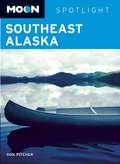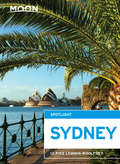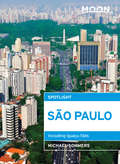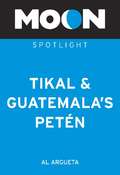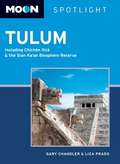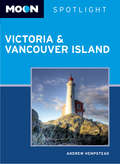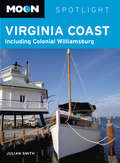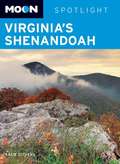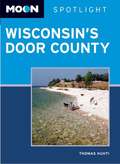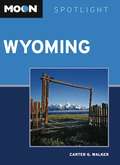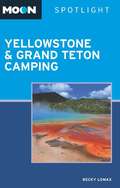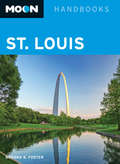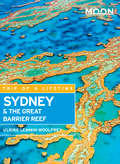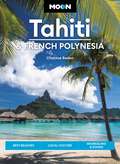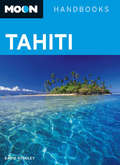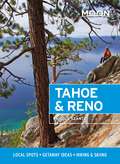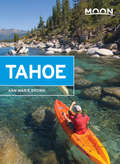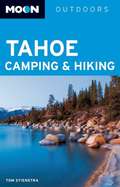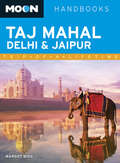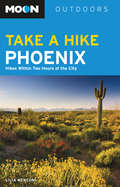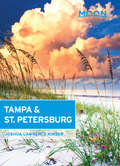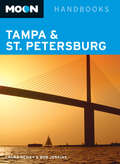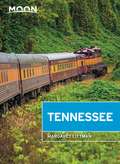- Table View
- List View
Moon Spotlight Southeast Alaska
by Don PitcherMoon Spotlight Southeast Alaska is a 144-page compact guide covering Southeast Alaska's highlights, including Ketchikan, Prince of Wales Island, Juneau, Glacier Bay National Park, and Skagway. Author Don Pitcher offers his firsthand advice on what sights are must-sees, and sightseeing highlights maps make planning your time easy. This lightweight guide is packed with recommendations on entertainment, shopping, recreation, accommodations, food, and transportation, making navigating the Alaska Panhandle uncomplicated and enjoyable.
Moon Spotlight Sydney
by Ulrike Lemmin-WoolfreyMoon Spotlight Sydney is a full-color, 80-page compact guide covering the city of Sydney, as well as surrounding areas. Author Ulrike Lemmin-Woolfrey offers her seasoned advice on must-see attractions, and she includes maps with sightseeing highlights so you can make the most of your time. This lightweight guide is packed with recommendations on entertainment, shopping, recreation, accommodations, food, and transportation, making navigating this iconic city uncomplicated and enjoyable.This Spotlight guidebook is excerpted from Moon Sydney & the Great Barrier Reef.
Moon Spotlight São Paulo
by Michael SommersMoon Spotlight São Paulo is a 70-page compact guide to the best of São Paulo. Brazil resident and magazine correspondent Michael Sommers offers his firsthand advice on what sights are must-sees, and sightseeing highlights maps make planning your time easy. This lightweight guide is packed with recommendations on entertainment, shopping, recreation, accommodations, food, and transportation, making navigating this bustling city uncomplicated and enjoyable.
Moon Spotlight Tikal and Guatemala's Petén
by Al ArguetaMoon Spotlight Tikal & Guatemala's Petén is a 60-page compact guide covering Tikal, the best-known Mayan ruins, and Guatemala's lowland jungle region. Author Al Argueta offers his seasoned advice on what sights are must-sees and includes maps with sightseeing highlights so planning your time is easy. This lightweight guide is packed with recommendations on sights, entertainment, shopping, recreations, accommodations, food, and transportation. Helpful maps make navigating this adventure-filled area uncomplicated.This Spotlight guidebook is excerpted from Moon Guatemala.
Moon Spotlight Tulum
by Gary Chandler Liza PradoMoon Spotlight Tulumis an 86-page compact guide covering Tulum, southern Quintana Roo, Chichén Itzá,and the Sian Ka’an Biosphere Reserve. Authors Gary Chandler and Liza Prado offer their seasoned advice on must-see attractions, and they include maps with sightseeing highlights so you can make the most of your time. This lightweight guide is packed with recommendations on sights, entertainment, shopping, recreation, accommodations, food, and transportation, as well as easy-to-read maps, making navigating these fascinating destinations uncomplicated and enjoyable.
Moon Spotlight Victoria & Vancouver Island
by Andrew HempsteadMoon Spotlight Victoria & Vancouver Island is a 100-page compact guide covering Victoria and Vancouver Island, including the Vicinity of Victoria, Southern Gulf Islands, Nanaimo and Vicinity, Highway 4 to the West Coast, Tofino, Oceanside, Comox Valley, and Northern Vancouver Island. Author Andrew Hempstead offers seasoned advice on must-see attractions and activities, and sightseeing highlight maps make planning your time easy. This lightweight guide is packed with recommendations on entertainment, shopping, recreation, accommodations, food, and transportation, making navigating this popular northern getaway uncomplicated and enjoyable.
Moon Spotlight Virginia Coast
by Katie GithensMoon Spotlight Virginia Coast is an 80-page compact guide covering Northern Neck, Middle Neck, Northern Hampton Roads, Norfolk, Virginia Beach, the Eastern Shore, and Colonial Williamsburg. Author Katie Githens offers her seasoned advice on must-see attractions, and she includes maps with sightseeing highlights so you can make the most of your time. This lightweight guide is packed with recommendations on entertainment, shopping, recreations, accommodations, food, and transportation, making navigating this historic area uncomplicated and enjoyable.
Moon Spotlight Virginia's Shenandoah
by Katie GithensMoon Spotlight Virginia's Shenandoah is a 60-page compact guide covering Winchester, Front Royal, Shenandoah National Park, Luray Caverns, and Natural Bridge. Author Katie Githens offers her seasoned advice on must-see attractions, and she includes maps with sightseeing highlights so you can make the most of your time. This lightweight guide is packed with recommendations on entertainment, shopping, recreations, accommodations, food, and transportation, making navigating this lovely, peaceful region uncomplicated and enjoyable.
Moon Spotlight Walt Disney World & Orlando
by Jason FergusonMoon Spotlight Walt Disney World & Orlando is a 90-page compact guide covering the Walt Disney World Resort and Orlando's other theme parks, including Universal Studios Florida and Discovery Cove, as well as the city of Orlando and Central Florida. Author Jason Ferguson offers seasoned advice on must-see attractions, and he includes maps with sightseeing highlights so you can make the most of your time. This lightweight guide is packed with recommendations on entertainment, shopping, recreation, accommodations, food, and transportation, making navigating the City Beautiful and its surroundings uncomplicated and enjoyable.
Moon Spotlight Wisconsin's Door County
by Thomas HuhtiMoon Spotlight Wisconsin's Door County is a 95-page compact guide covering Sturgeon Bay, Lakeside, Bayside, Washington Island and Rock Island. Author Thomas Huhti offers seasoned advice on must-see attractions, and he includes maps with sightseeing highlights so you can make the most of your time. This lightweight guide is packed with recommendations on entertainment, shopping, recreation, accommodations, food, and transportation, making navigating this renowned vacation spot uncomplicated and enjoyable.
Moon Spotlight Wyoming
by Carter WalkerMoon Spotlight Wyomingis a 175-page compact guide covering the soaring mountains, narrow valleys, and sweeping plains of Wyoming. Freelance writer and editor Carter G. Walker offers her seasoned advice on must-see attractions, and includes maps with sightseeing highlights so you can make the most of your time. This lightweight guide is packed with recommendations on sights, entertainment, shopping, recreations, accommodations, food, and transportation, as well as easy-to-read maps, making navigating this enchanting state uncomplicated and enjoyable.
Moon Spotlight Yellowstone & Grand Teton Camping
by Becky LomaxMoon Spotlight Yellowstone & Grand Teton Camping is a 206-page compact guide covering the region's best campsites, including those along the Gallatin, Madison, and Yellowstone Rivers. Writer, photographer, and naturalist Becky Lomax provides insight on each campsite, including the number of campgrounds, tips on gear selection and maintenance, clothing and footwear suggestions, and camping ethics. Each camp listing has at-a-glance icons that indicate nearby hiking or biking trails, hot springs, and spots for swimming, fishing, boating, canoeing, and kayaking. Lomax also shares which campsites and trails allow dogs. Easy-to-follow maps and clear driving directions lead campers and hikers to the best of these national parks.This Spotlight guidebook is excerpted from Moon Montana, Wyoming & Idaho Camping.
Moon St. Louis (Moon Handbooks)
by Brooke S. FosterAs a St. Louis resident, Brooke S. Foster knows the best ways to experience the Gateway City, from must-see sights like the Gateway Arch and the City Museum to great Northern Italian cuisine on the Hill. Foster provides travelers with unique trip strategies to help organize their visit, such as Blues, Barbecue, and Beer: A Legendary St. Louis Weekend; and From the Butterfly House to the Gigantic Slide: St. Louis with Kids. Including experienced advice on checking out the Victorian-era mansions in Lafayette Square, exploring the revived nightlife of downtown St. Louis, and seeing live music at the Blue Note in nearby Columbia, Moon St. Louis gives travelers the tools they need to create a more personal and memorable experience.This ebook and its features are best experienced on iOS or Android devices and the Kindle Fire.
Moon Sydney & the Great Barrier Reef (Moon Handbooks)
by Ulrike Lemmin-WoolfreyThis full-color guide to Sydney and the Great Barrier Reef includes vibrant photos and easy-to-use maps to help you plan the trip of a lifetime.The birthplace of modern Australia, Sydney is a bustling, cosmopolitan playground. Off Queensland's endless coast, the Great Barrier Reef is a playground of a different kind, a wonderland of coral gardens and colorful sea life. Larger than the Great Wall of China and home to thousands of species of wildlife, the Great Barrier Reef is an adventure-lover's paradise.In this book, expert traveler Ulrike Lemmin-Woolfrey tells you everything you need to know to make this trip possible, with tips on:How to get from Sydney to the Reef and where to stop along the way-including information on Cairns, Port Douglas, and TownsvilleHow to experience the Reef's world-class divingHow to choose the best reef cruises and rainforest toursHow to find and identify wildlifeand moreBackground on the diverse wildlife of the land and the sea-including how and where to see each species
Moon Tahiti & French Polynesia: Best Beaches, Local Culture, Snorkeling & Diving (Travel Guide)
by Chantae RedenWhether you&’re hiking through lush forests, diving deep among coral reefs, or just kicking back on the beach, indulge in island life with Moon Tahiti & French Polynesia. Inside you&’ll find:Flexible itineraries for solo travelers, honeymooners, and families, including two weeks experiencing the best of French Polynesia, a weeklong romantic getaway, and a trip to the awe-inspiring archaeological sites of the Marquesas Islands Must-see highlights and unique experiences: Dance to the beat of Tahitian drums at a Polynesian cultural festival, admire striking views of Moorea&’s volcanic landscape from Belvedere Lookout, and fall asleep under the stars from the comfort of your overwater bungalow in Bora Bora. Venture out to the Marquesas Islands for dramatic landscapes, secluded beaches, and the best handicrafts in the region, visit ancient tikis, and feast on delicious fresh seafood and tropical fruit Outdoor adventures: Get up close with migrating humpback whales and scuba dive with sharks, manta rays, sea turtles, and more. Trek along a jungle trail in search of refreshing waterfalls, paddle a traditional outrigger canoe across a bright blue lagoon, or unwind on the pink and white shores of idyllic Tikehau How to experience Tahiti and French Polynesia like an insider, support local and sustainable businesses, avoid over-tourism, and respectfully engage with the culture Expert insight from writer, photographer, and experienced diver Chantae Reden on where to eat, how to get around, and where to stay, from overwater bungalows and luxurious resorts to budget guesthouses Full-color photos and detailed maps throughoutReliable background information on the landscape, climate, wildlife, and history, as well as common customs and etiquette Experience the best of French Polynesia with Moon. Looking for more islands? Check out Moon Fiji or Moon Bali & Lombok.
Moon Tahiti: Including The Cook Islands (Moon Handbooks)
by David StanleySouth Pacific expert David Stanley knows the best way to vacation in Tahiti, from browsing the Papeete market to snorkeling off the island of Moorea. David also includes unique trip ideas like The Best of French Polynesia and Underwater in the Tuamotu Islands. Complete with details on taking lagoon tours and jeep safaris, lounging in Polynesian spas, and partaking in lavish seafood buffets, Moon Tahiti gives travelers the tools they need to create a more personal and memorable experience.
Moon Tahoe & Reno: Local Spots, Getaway Ideas, Hiking & Skiing (Travel Guide)
by Moon Travel Guides Nicole SzantoFrom the glittering lake and trail-lined mountains to Old West towns and artsy urban centers, experience the best of this adventurous region with Moon Tahoe & Reno. Inside you'll find:Flexible itineraries, including a week-long Lake Tahoe road trip, long weekends for both winter and summer, and the one-week best of Tahoe and RenoStrategic advice for hikers, skiers, beach bums, families with kids, foodies and brewery lovers, and moreThe best hikes in Tahoe: Find your adventure, from challenging mountain treks to serene meadow walks, with trail descriptions, difficulty ratings, and mapsOutdoor adventures for any season: Hit the slopes and get the first tracks through snow-covered pines or spark your adrenaline on the Heavenly Blue Streak zipline. Mountain bike along the breathtaking cliffside Flume Trail, whitewater raft down the Truckee River, and kayak the crystalline waters of Emerald Bay. Hike the rugged Rubicon Trail along the shores of Lake Tahoe to the remarkable Vikingsholm Castle or trek a section of the famed Pacific Crest Trail. Take a relaxing dip in a natural hot spring, soak in the serenity of a secret beach, and watch the sun set over the lakeMust-see highlights and unique experiences: Drive around Lake Tahoe's 72-mile shoreline, stop at scenic viewpoints, and meander through Old West mountain towns. Stroll past the sculptures and boutiques of Reno's Truckee Riverwalk or explore the interactive installations of Reno Playa Art Park. Take a ride on a 150-year-old railroad route or descend deep into an underground mine. See what's on tap at Reno's award-winning craft breweries, sip craft cocktails in a trendy lounge or try your luck at a casinoExpert advice from Tahoe local Nicole Szanto on where to eat, where to stay, and how to minimize your environmental impactFull-color photos and maps throughout, including a fold-out map Thorough background on the weather, wildlife, and history, plus tips on getting there and getting around by car and public transportationWith Moon Tahoe & Reno's practical tips and local insight, you can plan your trip your way.Want to keep on driving? Pick up a copy of Moon Northern California Road Trips.
Moon Tahoe (Moon Handbooks)
by Ann Marie BrownCalifornia outdoors expert Ann Marie Brown provides you with the essential details needed to discover all of the can't-miss sights, attractions, and restaurants in and around Tahoe. Ski Squaw Valley's renowned slopes, hibernate in a cozy South Shore cabin, dine in Tahoe City, or hike the Tahoe Rim Trail-Brown will help you maximize your time with her insider's tips no matter which of Tahoe's offerings you choose to take advantage of. Including creative trip ideas for a variety of travelers, such as Summertime Family Fun and Adrenaline Junkie,Moon Tahoegives travelers the tools they need to create a more personal and memorable experience.
Moon Tahoe Camping & Hiking
by Tom StienstraSeasoned camping and hiking expert Tom Stienstra extends travelers his firsthand advice on how to find the best spots in Tahoe to pitch a tent or hit the trail, from cobalt-blue Lake Tahoe's shores to adventure-filled Desolation Wilderness. Moon Tahoe Camping & Hiking's in-depth coverage also offers "best-of" lists-including Best Boat-in Campgrounds, Best Self-Guided Nature Walks, and Best for Waterfalls-ensuring that both outdoors beginners and experts will find the campgrounds and trails to match their skill levels and interests. Complete with clear directions to each location, detailed destination descriptions, difficulty and quality ratings for each hike, and helpful maps,Moon Tahoe Camping & Hikingprovides campers and hikers with all the necessary tools to head outdoors.
Moon Taj Mahal, Delhi & Jaipur
by Margot BiggWith its shimmering white marble domes and perfect symmetry, the Taj Mahal is among the most stunning marvels on the planet. A stroll through its lush grounds transports you back to a time when bejeweled royalty feasted on rich delicacies and terraced fountains flowed with rose water. Expert traveler Margot Bigg tells you everything you need to know to make this trip possible inMoon Taj Mahal, Delhi & Jaipur: #149; How to get there, how long it will take, and where to stop along the way#151;including information on excursions into Rajasthan, the Himalayas, and nearby wildlife preserves #149; How to choose the best guide and means of transportation, whether it's train, car, or bus #149; Where to find authentic cultural experiences, from elephant processions to spiritual retreats
Moon Take a Hike Phoenix: Hikes Within Two Hours of the City (Moon Outdoors)
by Lilia Menconi KummererThe Sonoran Desert draws visitors from far and wide to walk among the iconic Saguaro cacti, craggy boulders, and spiky plant life that can be found nowhere else. Phoenician Lilia Menconi grew up on these trails, and in Moon Take a Hike Phoenix, she shows you the best hikes in and around the city-all within two hours of Phoenix. With details on public transportation options and clear directions on how to reach the trailhead, Menconi has all the bases covered. Suggested lists of hikes include:Best Historical HikesBest Summit ViewsBest Hikes for SolitudeBest Kid-Friendly HikesBest Butt-KickersBest Hikes for Wildflower SeasonBest Hikes Near WaterBest Hikes for Wheelchair AccessLet Menconi show you all the worthwhile hikes, from short, flat routes suitable for families to day-long, steep treks for more advanced hikers. Each hike profile contains practical information including point-by-point trail navigation, contact information, facilities, fees, parking instructions, and an easy-to-use map for each trail. From South Mountain Park with its many petroglyphs to the white granite rock formations of White Tank Mountain Regional Park, your trip begins with Moon Take a Hike Phoenix.This ebook and its features are best experienced on iOS or Android devices and the Kindle Fire.
Moon Tampa & St. Petersburg (Travel Guide)
by Joshua Lawrence KinserMoon Travel Guides: Experience the Life of the City!Make your way through Tampa's lively downtown and historic harbor, explore St. Petersburg's myriad museums and galleries, or unwind on more than 35 miles of Gulf Coast beaches. Moon Tampa & St. Petersburg is the ultimate guide to this unique Sunshine State destination.What You'll Discover in Moon Tampa & St. Petersburg:Unique, firsthand perspective from travel writer and born-and-raised Floridian Joshua KinserFull-color guidebook with vibrant photos and detailed maps for navigating independentlyStrategic itineraries for every trip and budget, including: The Best of Tampa & St. Petersburg, Kid Friendly, and Foul Weather FunFocused coverage of Downtown Tampa, Ybor City, South Tampa and Hyde Park, Busch Gardens and North Tampa, Greater Tampa, Downtown St. Petersburg, St. Pete Beach and Gulf Port, Clearwater and Dunedin, and Greater Pinellas CountyHonest advice on finding the right accommodations and the best transportation routesActivities and ideas for every traveler: See pivotal surrealist artwork at the Salvador Dali Museum, or soar over the bay in the world's largest skydiving center. Discover the vibrant nightlife of Tampa's historic Latin Quarter, or indulge in a puff of the area's famed cigars. Get your kicks on one of the many thrill rides at Busch Gardens, or kick back with a daiquiri after a relaxing day on the beachDetailed and thorough information, including crucial background on culture and history, and geographyWith Moon Tampa & St. Petersburg's practical tips, myriad activities, and local insight on the best things to do and see, you can plan your trip your way.Visiting more of the Sunshine State? Try Moon Florida. Exploring by car? Try Moon Florida Road Trip.
Moon Tampa & St. Petersburg: 2009
by Laura ReileyWriter and Tampa resident Laura Reiley offers her unique perspective on Tampa and St. Petersburg, from exploring the Salvador Dali Museum to enjoying the quirky Gasparilla Pirate Fest. Reiley includes trip strategies for a variety of travelers, such as the Nature Lovers Tour and Tampa Sports, covering the Yankees spring training. Including expert advice on the Museum of Science and Industry, Busch Gardens, and nightlife in historic Ybor City, Moon Tampa and St. Petersburg gives travelers the tools they need to create a more personal and memorable experience.
Moon Tampa & St. Petersburg: 2013
by Laura Reiley Bob JenkinsTampa resident Laura Reiley and St. Petersburg resident Bob Jenkins offer their unique perspectives on Tampa and St. Petersburg, from exploring the Salvador Dali Museum to enjoying the quirky Gasparilla Pirate Fest. They include trip strategies for a variety of travelers, such as a "Nature Lovers Tour" and "Tampa Sports," covering the Yankees spring training. Including expert advice on the Museum of Science and Industry, Busch Gardens, and nightlife in historic Ybor City, Moon Tampa & St. Petersburg gives travelers the tools they need to create a more personal and memorable experience.
Moon Tennessee (Travel Guide)
by Margaret LittmanThe birthplace of the blues, the cradle of country music, and the home of the Smokies: get to know the Volunteer State with Moon Tennessee. Inside you'll find:Strategic, flexible itineraries, from a long weekend in Nashville to a Great Smokies road trip, designed for history buffs, families, outdoor adventurers, music lovers, and more, including day trips from Memphis and NashvilleThe best local flavors: Dig in to fiery hot chicken and authentic Southern barbecue or sip on samples at the Jack Daniels DistilleryCan't-miss music: Catch a performance on the Grand Ole Opry stage or follow in the footsteps of the King at Graceland. Two-step with the locals at a beloved honkytonk, listen to the strums of bluegrass, or tour studios where legends like Johnny Cash recorded their hitsOutdoor adventures: Go whitewater rafting in Cherokee National Forest, hike to rushing waterfalls in Great Smoky Mountains National Park, or spot wild bison in the Land Between the Lakes Expert advice from local Nashvillian Margaret Littman on when to go, where to eat, and where to stay, from rugged campgrounds to historic inns Full-color photos and detailed maps throughout Accurate, up-to-date information on the landscape, wildlife, and history of TennesseeTrusted recommendations for LGBTQ+ travelers, international visitors, seniors, and travelers with disabilitiesWith Moon Tennessee's practical tips and local know-how, you can experience the best of the state.Hitting the road? Check out Moon Nashville to New Orleans Road Trip.
